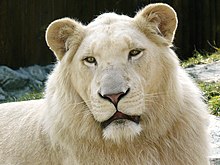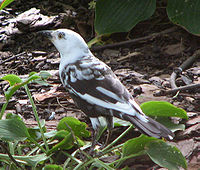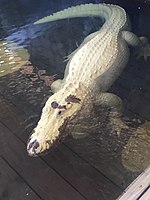Leucism


Leucism (/ˈluːsɪzəm, -kɪz-/)[2][3][4] is a wide variety of conditions that result in partial loss of pigmentation in an animal—causing white, pale, or patchy coloration of the skin, hair, feathers, scales, or cuticles, but not the eyes.[4] It is occasionally spelled leukism. Some genetic conditions that result in a "leucistic" appearance include piebaldism, Waardenburg syndrome, vitiligo, Chédiak–Higashi syndrome, flavism, isabellinism, xanthochromism, axanthism, amelanism, and melanophilin mutations. Pale patches of skin, feathers, or fur (often referred to as "depigmentation") can also result from injury.[5]
Details
Leucism is often used to describe the phenotype that results from defects in pigment cell differentiation and/or migration from the neural crest to skin, hair, or feathers during development. This results in either the entire surface (if all pigment cells fail to develop) or patches of body surface (if only a subset are defective) having a lack of cells that can make pigment.
Since all pigment cell-types differentiate from the same
More common than a complete absence of pigment cells is localized or incomplete
but is also found in many other species.Due to the lack of melanin production in both the
Notable examples
- Platypus (Ornithorhynchus anatinus) – in 2021, a leucistic example was found in the Gwydir River, near Armidale, New South Wales, Australia.[10]
Genetics
Etymology
The terms leucistic and leucism are derived from the stem leuc- + -ism, from Latin leuco- in turn derived from Greek leukos meaning white.
Gallery
See also
- Albino and white squirrels
- Amelanism
- Dyschromia
- Erythrism
- Heterochromia iridum
- Albinism
- Melanism
- Piebaldism
- Vitiligo
- Xanthochromism
References
- PMID 24045858.
- Oxford Dictionaries. Oxford University Press. Archived from the originalon August 10, 2012. Retrieved January 9, 2016.
- ^ Merriam-Webster, Merriam-Webster's Unabridged Dictionary, Merriam-Webster, archived from the original on 2020-05-25, retrieved 2015-11-12.
- ^ a b "leucism". The American Heritage Dictionary of the English Language (5th ed.). HarperCollins.
- ^ "Depigmentation of Skin: Symptoms, Signs, Causes & Treatment". MedicineNet. Retrieved 2020-06-23.
- ^ chemport.cas.org https://chemport.cas.org/cgi-bin/sdcgi?APP=ftslink&action=reflink&origin=npg&version=1.0&coi=1:CAS:528:DC%252BC3sXotlGksbg%253D&md5=1ee737efa06deefbbb993e3412a921a0. Retrieved 2020-06-23.
{{cite web}}: Missing or empty|title=(help) - ^ White crows at Cornell University.
- ^ Piebald ball pythons at Constrictors.com (archived 9 October 2006, from the original, accessed 18–22 July 2006).
- ^ "Oculocutaneous Albinism". NORD (National Organization for Rare Disorders). Retrieved 2020-06-23.
- ABC News Online, 2023-11-03
- ^ Coat color, dominant white Archived 2009-01-30 at the Wayback Machine at Online Mendelian Inheritance in Animals.
- ^ An L1 element intronic insertion in the black-eyed white (Mitf[mi-bw]) gene: the loss of a single Mitf isoform responsible for the pigmentary defect and inner ear deafness at Human Molecular Genetics.
- ^ Waardenburg syndrome at Atlas of Genetics and Cytogenetics in Oncology and Haematology (archived 26 December 2005, from the original, accessed 18–22 July 2006).
External links
 Media related to Leucism at Wikimedia Commons
Media related to Leucism at Wikimedia Commons








